
You quickly get used to good things and when breaks down central locking , then there is no need to delay repairs. The cause of the breakdown can be determined by the symptoms and in most cases repair the central lock with your own hands is not difficult. However, in some cases solve the central locking problem The only way is to replace it.
How install central locking in VAZ 2110 I won't tell you, because... detailed instructions is in the VAZ 2110 documentation (connection diagram for the central locking VAZ 2110), but I’ll try clearly show various breakdowns of the electric lock and ways to solve them.
Central locking (CL) or another way electronic lock consists of an activator (actuator, electric door lock drive), wiring, traction. Therefore, if you have The electric lock is broken and not working, then the problem lies in these components.
The VAZ 2110 can use various activators. They may differ in effort, small features in design, manufacturer/country, etc., but their operating principle is similar: 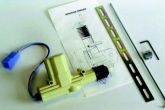
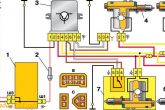
![]()
Operating principle of the central locking activator
In order to understand why doesn't the electric lock work?, you should consider the principle of its operation:
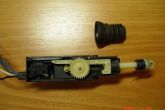 |
Five-wire activator with cover removed. There is a boot above the activator. Two activator wires are connected to the electric motor. The remaining three wires are connected to the limit switch. |
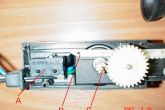 |
In this photograph, the fragment with the image of the limit switch is enlarged, it is indicated by the letter “A”. “B”—stem shank in extended position. “C” is the motor shaft with a gear mounted on it. |
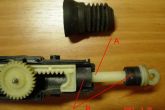 |
“A” - the rod is extended. “B” - damper rubber rings. They protect the rod and body from damage when impacted in the extreme positions of the rod. |
It is not correct to check the operation of the activator without rigid fixation (without mounting on the door) and without connecting the rod, because
after being triggered to the extreme retracted or extended position, the rod will rebound in the opposite direction.
Power steering VAZ With us you will find any auto parts at competitive prices for your car!avtobazar.ua
Problems with the central locking
Consider the moment when the driver closes the car, the doors close and immediately open.
 |
If we consider this case in detail, it turns out that the rod is retracted almost completely, and the limit switch is in a borderline state (it may or may not be pressed). The limit switch will send a command to the central locking module and the other doors will also close, but as a result of slight deformation of the door or mechanism (for example, a small impact on the car, heating/cooling of the door metal, etc.) the limit switch may switch back and the central lock will open. The defect may appear when closing the door, when the standard mechanism springs the rod and, accordingly, the rod into the reverse position and the doors open again. |
To make sure that this is the problem with the central locking in your case, you need to turn on the alarm while sitting in the car and try to press the door lock button down with your hand (to prevent a spring defect in the mechanism). If the doors do not open, then this means the above-described defect in the mechanism for adjusting and fastening the activator and its rod.
Why is there no such problem with central locking on foreign cars?
Because there the command to open the lock is given by other circuits that do not receive a signal confirming the position of the rod.
If the central locking only works in one direction, and in the other not, but when an attempt to move occurs, then perhaps the reason is poor fastening of the screw on the activator rod.
The problem is when When closing/opening the central lock there is a rattling noise and the rod does not move.
It's all about the plastic parts. The intermediate gear transmits rotation from the gear on the motor shaft to the teeth of the rod. Because The gear is plastic, then over time the teeth will chip and break. 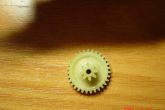
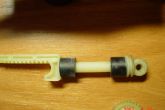
This failure of the central locking system is often found in Alpha activators. The pin on which the idler gear is mounted breaks the mounting hole, or this hole may be large sizes than necessary. Hence the skew of the gear, jamming of the activator, and a similar cracking of the teeth from their loose fit.
So does everyone else plastic elements activator over time and from not correct installation the central lock may break.
Activator motor has a brass gear, which over time will break down the plastic of the gear, and the gear on the shaft will simply spin. 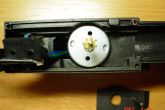
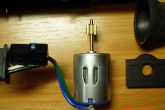
The problem is when The central locking does not work, but the rod can move as usual, by hand. Or central lockingdoes not always work (every time). In this case, the central locking motor failed. The activator motor is disassembled, where “A” is the commutator pole with a winding soldered to it, “B” is the commutator poles, and “C” is the commutator brushes. 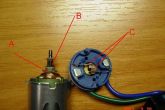
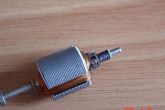
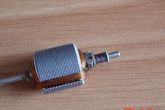

The central locking motor may not work for a number of reasons:
Car headlights and optics Headlights for cars with delivery throughout Ukraine. Original and analogues. Address and phone number aksmir.com.ua
Correct installation of the central locking (activator)
Incorrect installation of the activator in the car door increases wear of parts, that leads to breakdown of the central lock.
Install activator can be done as desired (vertically, horizontally or at an angle), just as the closure can be by extending the rod or vice versa.
It is important that there is enough space for the activator to work, there is enough space for the rod to pass through, there is also a convenient and reliable connection of the rod, and the fastening is accessible.
Check the operation of the central locking should be done with the windows lowered and after installing the door trim. 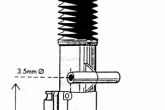 Activator mount should be at maximum flat surface. A slight misalignment when fastened to an uneven surface with the force of self-tapping screws can cause difficulty in the operation of the gear shafts. When installing the activator, it is recommended to use washers or bushings to level the surface. If the activator gets into holes in the metal of the door, then it is necessary to use the plate from the activator kit.
Activator mount should be at maximum flat surface. A slight misalignment when fastened to an uneven surface with the force of self-tapping screws can cause difficulty in the operation of the gear shafts. When installing the activator, it is recommended to use washers or bushings to level the surface. If the activator gets into holes in the metal of the door, then it is necessary to use the plate from the activator kit.
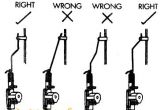 The design of the VAZ 2110 door implies bending rod, so it is important to bend the rod correctly. The angle should be clear and preferably minimal. If the angle approaches the arc or the distance of the activator attachment from the rod itself is very large, then instead of the effort of moving the standard rod we will get a force to overcome the bend of this arch. It is clearly visible in the second figure, where the activator, pushing the rod upward, will apply force to the standard rod not upward, but to the side.
The design of the VAZ 2110 door implies bending rod, so it is important to bend the rod correctly. The angle should be clear and preferably minimal. If the angle approaches the arc or the distance of the activator attachment from the rod itself is very large, then instead of the effort of moving the standard rod we will get a force to overcome the bend of this arch. It is clearly visible in the second figure, where the activator, pushing the rod upward, will apply force to the standard rod not upward, but to the side.
If the central locking does not work correctly and the activator does not always have enough power to open or close the door, you should focus your efforts on finding the cause and eliminating the malfunction. However, enthusiasts have found another solution to this problem - modified central locking VAZ 2110(installed the second activator). That is, the second activator is additional and helps the work of the first standard activator. The yellow arrow is the direction of movement of the rod of the standard mechanism, and the red arrow is the movement of the additional activator. 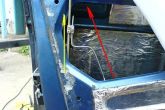
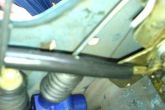
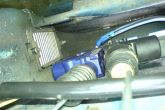
In fact If the activator is installed correctly, no additional activator is required and one activator can do its job perfectly.
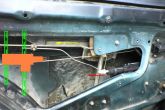 An example of incorrect installation of the central lock. The yellow arrow is the movement of the standard rod, the red arrow is the movement of the activator rod. As a result, the force of the rod will be applied to the fracture and the steel rod will eventually begin to pop out of the rod hole. The error can be eliminated by installing plates ( green color) under the activator (orange). Thus, the activator will be as close as possible to the standard rod and bends in the activator rod will be minimal.
An example of incorrect installation of the central lock. The yellow arrow is the movement of the standard rod, the red arrow is the movement of the activator rod. As a result, the force of the rod will be applied to the fracture and the steel rod will eventually begin to pop out of the rod hole. The error can be eliminated by installing plates ( green color) under the activator (orange). Thus, the activator will be as close as possible to the standard rod and bends in the activator rod will be minimal.
Correct fastening of the lock rod 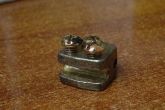 Rod fastening element has a through hole for the activator rod and a split side for attachment to the standard rod. If the fixing screws are loosened, then this element should move freely on the activator rod. We select the mounting location and fix the screws with proper force. Push the activator rod down by hand, then push the standard rod in the direction corresponding to the closed state of the door lock.
Rod fastening element has a through hole for the activator rod and a split side for attachment to the standard rod. If the fixing screws are loosened, then this element should move freely on the activator rod. We select the mounting location and fix the screws with proper force. Push the activator rod down by hand, then push the standard rod in the direction corresponding to the closed state of the door lock.
After both rods are retracted, we fix the screw on the activator rod with medium force. Holding the standard rod in place, we extend the activator rod together with the fastening by 2-3 mm and fix the fastening with medium force on the standard rod of the lock.
Checking work: We check with our hands the movement of the activator together with the door lock mechanism; the latch must be closed. We check the opening of the latch in the extreme positions of the activator. We check in what positions the remaining doors close. The main thing is that this should not be one of the extreme positions or close to the extreme position of the additional activator. We check the movement of the window lifter. We apply the door trim to ensure subsequent fastening and the absence of protruding elements. If everything is fine, tighten the screws securing the rods with maximum force.
We check the operation of the activator by hand again. We check the operation of the activator from the battery. We briefly touch the long wires from the battery to the activator wires, change the polarity and operation of the activator in a different direction.
A number of deviations, amendments and wishes:
 If fastening screw No. 2 on the rod becomes loose, then there may be several options:
If fastening screw No. 2 on the rod becomes loose, then there may be several options:
The rod slides in the hole and the lock does not move.
The lock either closes or opens. This happens because the sharp edges of the element (at points 1) can bite the rod and, depending on the upper or lower point, will either only close or, on the contrary, open.
Installing the activator on cable traction
Actually, the installation is similar to that described above, but the attachment to the locking mechanism cables is shown in the photo.
Fig2: Fastening the kit to the metal of the door and fastening the cable in the jacket
Fig3: The cable is released from the jacket between the fastenings.
Fig4: Connecting the activator rod to the cable. 
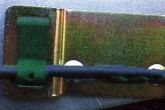
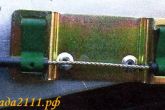

This kit is difficult to find on sale, so the plate can be cut out of metal yourself, and the spring fastenings can be taken from the Gazelle stove (fastening the cable jacket). Activator.
Conclusion
Causes of central locking failure many, some of them related to climatic conditions(cold winters, high humidity etc.), and partly due to incorrect installation or adjustment of the central locking. In any case, from the symptoms you can understand where approximately or exactly problem with the electric lock.
By the way, do you know how to install additional. central locking button?
You begin to appreciate many things after they are gone. The same applies to the additional options of the VAZ 2110. Central locking (CL), for example, you can not notice as long as it works properly or you can do without it altogether. But you quickly get used to good things, don’t you? Therefore, when something that provides us with a comfortable ride fails, you immediately begin to rush around in search of answers “how to fix it.”
VAZ cars are not least good for their high maintainability. Whenever something happens to your iron horse, you can almost certainly solve the problem yourself without the help of specialists at a service station. “Ten” was no exception in this regard.
As for the central locking system specifically on Lada 110 cars, this is really a rich topic for discussion. Ignorance of elementary circuits and the operating principle of the unit can confuse many motorists. However, servicing the mechanism is quite simple. And given the enviable frequency of its failure, it turns out that knowing “how” is simply vital.
The purpose of this type of device is centralized management an automatic mechanism for opening and closing all doors in the car at once. This is especially convenient for working in conjunction with an alarm system and when operating a car in general. However, the reliability of the operation of the central locking system should definitely be checked every time by moving the handles of all four doors before going about your business for a long time, since the actuator can often fail and one of the doors may remain unlocked.
Structurally, the VAZ 2110 central lock consists of the following elements:
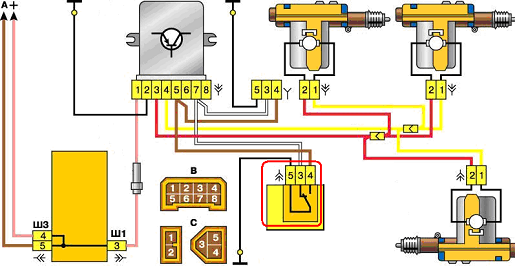
The problem of improper operation of the actuator is not at all uncommon for cars in the domestic automobile industry. Despite the fact that there are a number of reasons for the failure of mechanism parts, the principle of operation automatic system Closing the doors is quite simple, and the malfunctions are quite typical in their entirety. This means that any motorist can deal with them.
You don’t have to grab your head and run to the workshop in search of a qualified specialist. Thanks to the diagnostic recommendations below, you yourself high probability you can become one. If, for some reason, you don’t want to get your hands dirty, at least no one else will dare to mess with you. And this, you see, also costs a lot.
The central locking actuator is quite fragile and does not tolerate overload. The activator body, made of plastic, can easily melt if the frequency of door closing is excessively high. The duration of the control pulse also plays an equally important role. Try to always remember about the extreme fragility of the activator and not to load it during operation.
It is easy to guess that the activator is located in each individual door of the car. If the body of one of them melts due to overheating of the electric drive commutator, this becomes the cause of many problems:
The actuator mechanism is entirely made of plastic. Gears can easily wear out and break during operation, or melt when the commutator overheats. As a result, when the central locking operates, characteristic creaking sounds are heard - a sure sign of imminent failure of the activators. Likewise, if the gearbox of the mechanism is humming, but the doors do not open or close.
Malfunctions of this kind can also be associated with all sorts of defects in the gearmotor and its traction. If you have recently replaced your central locking system, the reason may be that it was installed incorrectly. The mechanism may also be incorrectly adjusted or the fastening may be broken. In any case, the door trim should be removed and checked visually.
The first possible problem follows smoothly from those mentioned in the previous section. Overload in the operation of activators leads to an increase in the operating current in the supply circuit above the rated value. As a result, the fuse blows and the central locking of the VAZ 2110 simply “dies”.
It is by checking the fuse that the diagnosis of central locking malfunctions begins. By the way, it is located in a very specific place and it is not easy to find it right away even if you know where to look. In order to get to it, you will need to fold back the central panel with the fuses and dig into the entire wiring harness in the niche that opens behind it. The “comrade” you need is packaged in a special plastic cup and connected to the pink wire.

Another very common and obvious problem is the central locking connector. It is located in the most unfavorable place for this in the interior body, under the foot mat. A large amount of moisture and dirt inevitably gets there. Electrical contacts are intensively oxidized. As a result, the power supply circuit involuntarily breaks at the point where the plug connector is connected.
Electronics, of course, are reliable things. Modern control modules for the central locking VAZ 2110 are assembled using a transistor control circuit. This eliminates their mechanical wear. The shelf life of key components is measured in tens of years. The control unit is located under plastic cover torpedoes on the right side of the driver's seat.
However, power transistors can easily fail when the activators are overloaded and the collector is short-circuited. It may even happen that the signal from the control unit will constantly be sent to the lock drive if the transistor is broken. Otherwise, it will simply not turn on.
Checking the control unit is extremely simple. The voltage from the negative terminal of the battery, or directly from the pink wire supplying the control unit, is supplied to the contacts of the gearmotor (activator) in series to the red and yellow conductors. All of the above contacts can be found directly on the eight-pin connector of the control unit.
VAZ-2110 is an additional option and is not included in every vehicle configuration. In fact, the mechanism is quite cheap, easy to install, repair and use, but at the slightest breakdown the car owner faces difficulties. It is not very convenient to check whether the lock flags are lowered before each exit from the car. It is much easier to close all the locks by pressing one button on the alarm remote control or turning the key in the driver's door cylinder.
The main function of the device is clear from the name: it is used to unlock and lock all car door locks at the same time. The operation of this device can be carried out both in conjunction with a car alarm and without it. The basis of the device is the VAZ-2110 central locking unit, which is a small circuit containing several semiconductor elements and electromagnetic relays. Instead of the latter, not relays, but transistor power switches can be used.
Despite all the advantages of central lock control, you should not trust it completely, especially if certain sins have been observed. In case of minor failures, one or more locks may not close completely. The reason for this may be a malfunction of the electric motor, the gearbox included in its composition, or the control system. For carrying out even small repair work You need to know the structure and operating principle of the central lock.
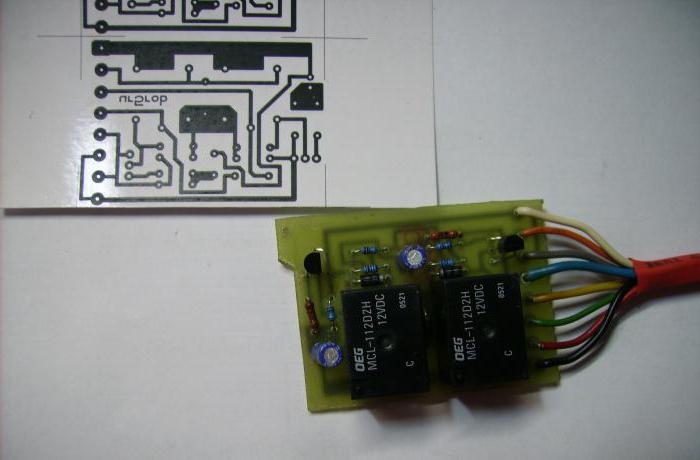
The central lock (VAZ-2110) has the following components in its design:
The VAZ-2110 central lock can operate in several modes:
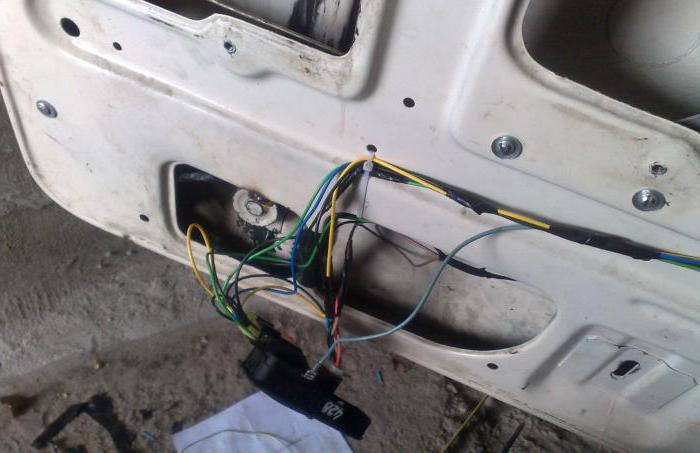
If the VAZ-2110 central locking does not work, the cause is some defect in the actuators - gearmotors. In the entire structure, they are the most vulnerable point, since they are subject to the greatest load. These devices move during operation, which speeds up the production of the elements included in their design.
But there is one important detail - VAZ-2110 cars were discontinued more than ten years ago, which already suggests that any of the cars will have problems associated with the “obsolescence” of elements. The wiring is destroyed, gear motors become unusable, even transistors in the control unit can fail over such a period due to frequent overheating. Therefore, it is necessary to carefully study all the symptoms of breakdowns and methods for eliminating them.
It is with their help that the VAZ-2110 central lock is controlled. They are mounted in the doors and have a plastic body. Incidents of meltdown are rare, but they do happen. Especially if the device is subject to a large load or the motor is frequently triggered. In case of a physical defect (melting, destruction), the following symptoms appear:
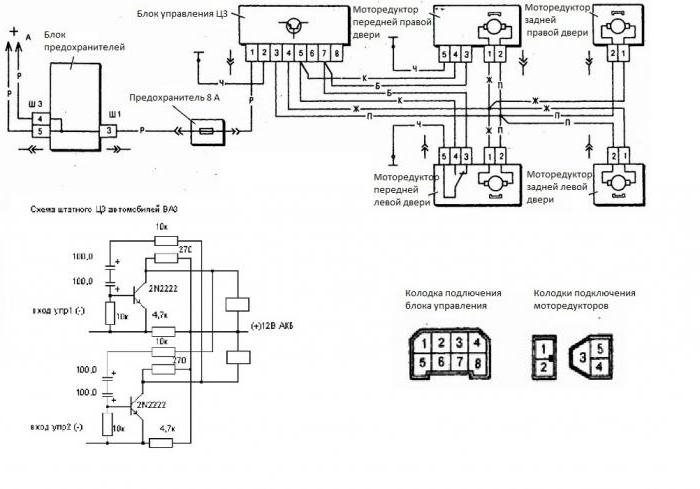
Almost all activator components are made of plastic. It is quite durable and can withstand heavy loads. But there are also defects and lock malfunctions. In the latter case it happens sharp increase load on the motor, the gears can collapse and become disengaged. The lock will buzz, but the flags will not go down (or up, depending on the current state).
But such a manifestation of breakdowns can also be caused by incorrect installation. This is only the case if work has taken place relatively recently, directly or indirectly affecting the elements of the central lock. Failure to adjust the rods is the first sign that the entire system will not work correctly. The lock on which the adjustment is incorrect will not work, while the others function properly.
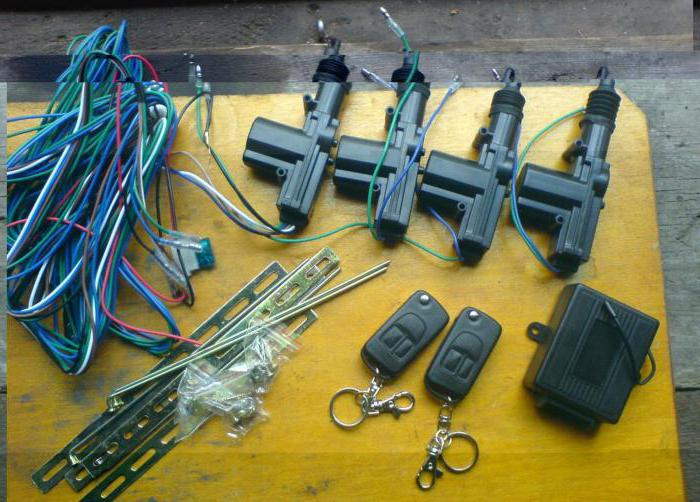
Every motorist who has at least once encountered it knows where the central locking (VAZ-2110) is located. It is located under the central part of the dashboard, right on the floor. It is quite simple to distinguish it: the block is made of plastic, a wiring harness with a block at the end fits into it. Having removed the cover from the block, you will see a small board inside it. It is this block that is responsible for the functioning of the entire system. And the reasons for its failure may be the following:
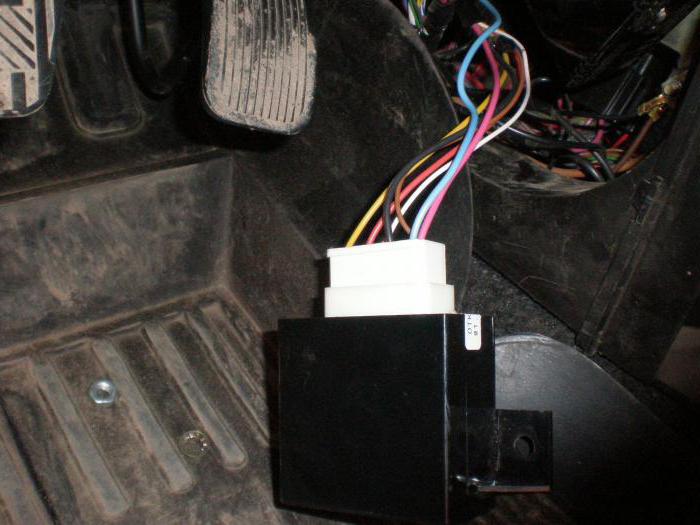
The VAZ-2110 central locking circuit consists of semiconductors and electromagnetic relays. But the latter are not used in all central locking models. After all, it is much more efficient to use transistor switches; they work on the principle of a relay, but there is no physical stress. As a result, mechanical wear is completely excluded. But there is still a chance of breakdown of semiconductor elements.
If there is a breakdown, the central locking system on the top ten will either be constantly set in motion, or will completely stop responding to actions. To check the operation of the control unit, it is necessary to connect alternately to the yellow and red wires of the driver's door gearmotor. Preferably directly on the connection block to the control unit. If the flags go up and down normally, then there is no point in blaming the electronics for failure; you need to look for the cause in other components.

Next important element The entire system is electrical wiring. The operation of the central lock depends on its condition. If there are abrasions on the wires or cuts, this will inevitably lead to either spontaneous activation of the activators or to their inoperability. Most often, the wiring is destroyed at the bends - between the door and the body. To check the integrity, you need to test each wire separately. Just remember to turn off the power, otherwise you will damage the multimeter.
The limit switch allows the control system to understand in what position (locked or unlocked) the door is currently located. With its help, a signal is sent to unlock and lock the VAZ-2110 central locking relay. In the event of destruction, a picture may be observed in which a signal to unlock is received, but a signal to lock is absent. To make repairs, you need to completely change the driver's door activator. These elements cannot be repaired, so in case of breakdowns, only complete replacement will help.
Cars produced in the 21st century are very technologically advanced and safety-conscious. They include many devices for the protection and comfort of the car owner. The domestic auto industry is trying to keep up to the best of its ability - this is how a central lock appeared in the VAZ 2109 and 2110.
The presence of a central lock in a VAZ car refers to additional options, and even then, if we talk about cars produced after 2000. However, in VAZ 2109 models deprived of this advantage, it is not difficult to install it.
The main purpose of the VAZ 2109 central lock is to automatically open and close all car doors simultaneously. The central locking can be controlled using an alarm remote control that interacts with the system, as well as using a key. The central locking mechanism consists of several sensors located in the door envelopes, and circuit breakers. This entire system is interconnected and looped into the vehicle’s power supply.
If you are interested in such a device, you can install it yourself at home. You can buy central locking for the VAZ 2109 at almost any auto store. They are the same type of design, so the lock from other VAZ cars will also work. For installation, in addition to the lock, you will need several screwdrivers and keys, as well as desire and patience.
Before starting work, you need to disconnect the terminals from the car battery, since installing the lock requires connecting the power supply. After this, you can begin to remove the cards with the casing. During the removal process, the latches that hold them in place may break, so prepare new ones in advance.
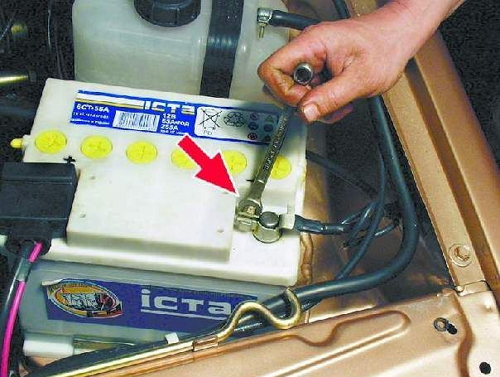
Next you need to choose the right place for. It is worth considering the peculiarity of moving the glass mechanism. In rare cases, you may need to purchase additional mounts for the car envelope. The central lock is attached to self-tapping screws and bolts with nuts. Basically, the factory provides a place for installing a lock, and there are also special electrical chips for connecting it.
If there are no such chips in the envelope of your VAZ 2109, then you will need to extend the wiring to the on-board computer control unit. It is located inside the car under the stove shaft. Connecting the power supply correctly will not be difficult for you, because all the chips are universal. A similar installation procedure must be done with the rest of the car cards. It is best to run the wiring from the rear door locks along the thresholds of the car.
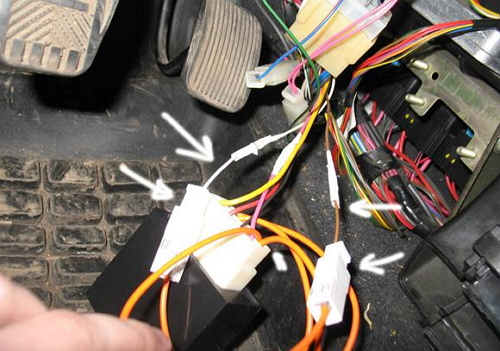
After installing the central locking mechanism, make sure that all doors operate correctly. It is very important that the lock bars move freely and do not interfere with the opening of the main lock handle, as well as the lowering of the car window. During installation everything metal connections needs to be lubricated. And only after that proceed to reassembling the cards with the casing.
Quite often it happens that the system fails to work - if you are the owner of a domestic car, you are no stranger to breakdowns. This may be a partial breakdown, which in some cases requires cleaning the mechanism from dust or more accurately aligning the lock mounting rods, or minor failures in the power supply system. Sometimes a complete failure of the entire device occurs, which requires replacement of some elements of the mechanism.
Often, central locking sensors fail and are easy to replace. Since the lock is directly connected to the car alarm, in our case it is necessary to start the check with it. Try opening and closing the driver's door lock with the key. If the central locking system works, then the problem is with the alarm. If there is no alarm in your car, then proceed immediately to checking the entire lock system.
The main cause of failure in the central locking mechanism is a device called the activator.
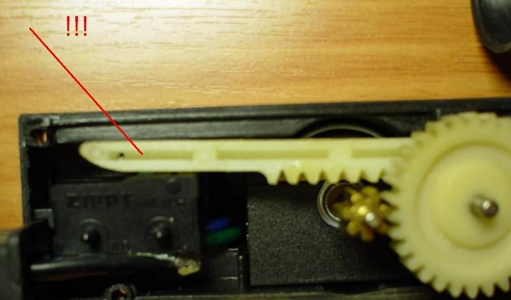
It is installed in the front doors of the car. Its main action is to send an electrical signal to the remaining doors to open or close them. When the activators are triggered, the signal is sent to the central board, which contains fuses. Although they fail quite rarely, they also need to be checked.
Additional fuses are located in the car envelope itself, near each mechanism with a rod. If the lock does not work on exactly one door, then the problem is located there. To fix it you will need a new fuse and a set of tools. Very often, VAZ 2109 owners come to a different solution and connect the wires directly, but this is not recommended, because in the future the entire central locking system may completely fail.
The central locking mechanism is designed in such a way that if the activator in the driver's door envelope breaks down, the rest will also not work. If you have a problem with the manual door opening button, then look for the reasons in the violation of the fixation of the activator rod fastening.
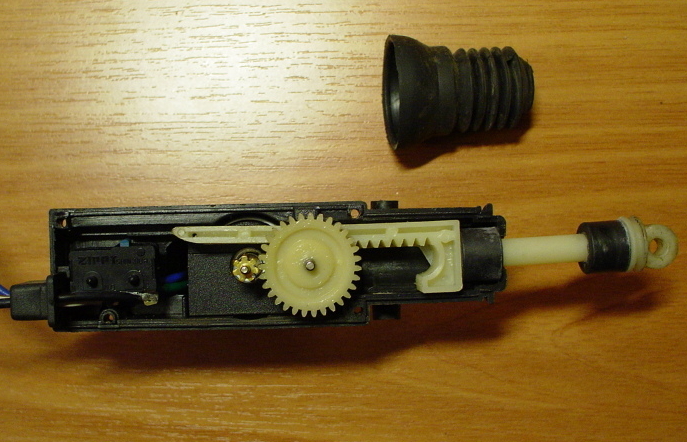
When connected electrical circuit It is best to make the VAZ 2110 work when you turn the key in the ignition. This will keep you safe while traveling. To make this type of connection, you must carefully read the installation instructions. If necessary, you should call an electrician for help or carry out the installation at a specialized car service center.
The VAZ-2110 central lock is considered a fairly safe device for the owner of this car. Keeping pace with progress, a person strives to be in time everywhere. This type of transport, such as a car, has long become not a luxury, but a means of transportation. According to statistics, every second person drives a car.
1. Mounting block. 2. 8 A fuse. 3. Control unit. 4. Right front door locking motor. 5. Right locking motor back door. 6. Left rear door locking motor. 7. Motor reducer for locking the left front door with a contact group. A - to power supplies; B - conventional numbering of plugs in the control unit block; C - conventional numbering of plugs in the blocks of geared motors for locking locks.
Today, the products of the domestic automobile industry are not in great demand, since foreign cars dominate the market. But not everyone can afford a foreign car. Therefore, people buy cheaper domestically produced vehicles. One of these cars is the VAZ 2110, which was distinguished by its stable performance, low cost of repair and easy operation.
Central locking is a system that, when given a certain command, performs the function of opening or closing an object. For ease of use, this operation is performed remotely. Some car enthusiasts choose the function of closing all doors after a certain period of time. It is very convenient for those cases when the driver does not have time or forgets to close the car door.
As a rule, using a long-range remote control you can control both the trunk and the hood, close and open the windows. The most common control method remote control- this is a press of one button, after which all the locks on the car are activated. If the remote control does not work for some reason, then you need to insert the key into door lock and turn it clockwise.
If an accident occurs, the car's security system is activated automatically and all locks open. At the heart of the central locking mechanism are incoming sensors located in the structure itself. These are microswitches and door switches (limit switches), actuators and a control unit.
The limit switch must maintain the door position and this information must be transmitted to the control unit. Switches fix the structural part door lock. The front doors of the car are equipped with a cam device. To fix the cam, the front doors are equipped with microswitches: there are two parts for each mechanism.
Blocking the lock is formed by one switch, and unlocking is formed by the second. There are two more microswitches used by the central locking mechanism. A fifth switch is installed on the lever device in the lock drive. It serves to determine the door position: when the door is open, the switch contacts close and the central locking system is deactivated.
The electronic mechanism (unit) receives the signal from the microswitches and sends information to the central control. In order to open an object, the central device sends a signal to certain control units, thereby activating the mechanisms in the locks.
As we know, any equipment fails sooner or later. And the central locking on the VAZ 2110 is no exception. There are a number of problems that manifest themselves in the operation of this system. Many car enthusiasts inadvertently destroy security system car. The driver should not give a long or rapid impulse when requesting a door to be opened or closed.

Central locking diagram for VAZ 2110
This action can damage the activator with which the closing device operates. When a long pulse is applied, the collector of the activator electric motor heats up very much. In this regard, the brush holder begins to melt and it may jam. After this, the activator will need to be replaced.
A fuse protects the central locking circuit. It is from this point that they begin to search for faults in the operation of the entire circuit. It is located inside the car, behind the fuse box. According to the diagram, it is located at the break of the pink wire (in insulation). Under the driver's mat there is a wire with a plug connector, which accumulates moisture and oxidizes. The power supply to the activator is lost.
Might break modular block central lock. Its functionality should be checked by applying voltage from battery to the module connector pin. The gear activator gears are made of plastic. Such parts are subject to wear and tear and this is a mechanical failure.
But the solenoid is considered the weakest point of the central lock; most often it is the one that fails. The electromagnet is controlled via a switch. When opening and closing doors, the life of the solenoids is calculated for approximately 10 thousand operations. After this number of switchings, malfunctions begin. The repair is simple: you need to replace the solenoid itself.